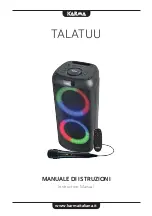
0 dB
-18...+18 dB
GAIN defines the amplification (increase) or attenuation
(reduction) of parametric EQs or low shelving and high
shelving equalizers.
20 / 20000
Hz
20 Hz...20 kHz
FREQ (frequency) sets the center frequency of a parametric
EQ or the cut-off frequency of shelving and Hi / Lo pass
filters.
6dB/Oct
6dB/Oct,
12dB/Oct
SLOPE sets the steepness or filter-order of low or high
shelving equalizers and low or high pass filters. Setting
different slopes within the transmission range is possible.
That, in conjunction with the Q-parameter, offers the
possibility for a hi-pass filter to be programmed for B6-
alignment, which describes a drastic rise in the cut-off
frequency range.
or
1.9 Oct or
0.7
0.04...2.86 Oct
or
0.4...40
Q or BW defines the quality or bandwidth of a parametric EQ.
A high Q-value results in a narrowband filter, while a small Q-
value results in a broadband filter. The Q-value also sets the
quality and thus the response of Hi, Lo and All pass filters
with slopes of 12dB/ oct.
BYPASS switches the corresponding filter ON (not engaged)
or OFF (engaged), which allows for quick A / B-evaluation of
the actual effect that a filter has on the sound.
ALL FLAT resets all 10, 15 or 31 bands and also LF- and HF
FILTER to 0 dB.
CAUTION: Using ALLFLAT discards all gain settings.
Filter Editing via ”Mouse Movement” in the Graphics Display
A white dot in the frequency response display represents an active filter (BYPASS and Drag Points Off not engaged).
Clicking with the left mouse button on this dot and keeping the mouse button pressed down allows changing the
selected filter’s amplification by moving the mouse up or down.
For an improved overview the name of the corresponding filter band appears in color as soon as the mouse cursor is
positioned over its white dot.
HIGH-PASS FILTER
High-pass filters pass high frequencies and stop low frequencies. Since it is not realistically possible to
create a perfect filter that passes high frequencies totally unaltered and stops low frequencies completely, high-pass
filter design involves compromises that allow some rounding of the corner at the filter cutoff frequency and some slope
in the transition to the low frequency stop band. Different compromise schemes are given different names; examples
are Bessel, Butterworth, and Linkwitz-Riley high-pass filter types.
The cutoff frequency is defined as the frequency at which the magnitude of the filter response has fallen to -3 dB
relative to the unfiltered signal in the Bessel and Butterworth types, and to -6 dB in the Linkwitz-Riley types. The cutoff
frequency is continuously variable from 10 Hz to 20 kHz.
IRIS-Net
DIGITAL MATRIX | en 419
Bosch Security Systems B.V.
User Manual
2017.05 | 3.20 | F.01U.119.956
Содержание IRIS-Net
Страница 1: ...IRIS Net en User Manual ...
Страница 2: ......
Страница 146: ...IRIS Net REMOTE AMPLIFIER en 146 Bosch Security Systems B V User Manual 2017 05 3 20 F 01U 119 956 ...
Страница 148: ...IRIS Net REMOTE AMPLIFIER en 148 Bosch Security Systems B V User Manual 2017 05 3 20 F 01U 119 956 ...
Страница 151: ...IRIS Net REMOTE AMPLIFIER en 151 Bosch Security Systems B V User Manual 2017 05 3 20 F 01U 119 956 ...
Страница 153: ...Layer 5 Control Page IRIS Net REMOTE AMPLIFIER en 153 Bosch Security Systems B V User Manual 2017 05 3 20 F 01U 119 956 ...
Страница 648: ...IRIS Net DIGITAL SOUND PROCESSOR en 648 Bosch Security Systems B V User Manual 2017 05 3 20 F 01U 119 956 ...
Страница 693: ...IRIS Net DIGITAL SOUND PROCESSOR en 693 Bosch Security Systems B V User Manual 2017 05 3 20 F 01U 119 956 ...
Страница 992: ......
Страница 993: ......
















































